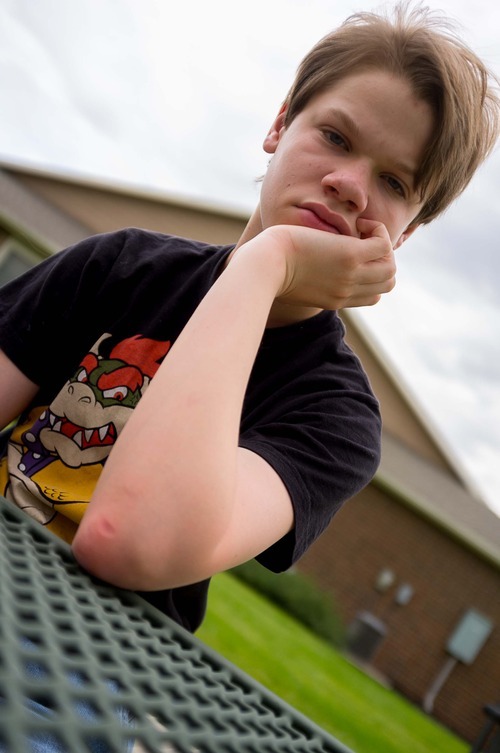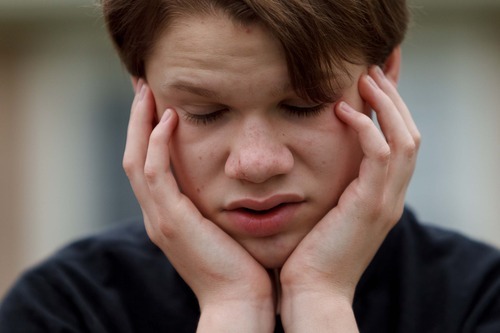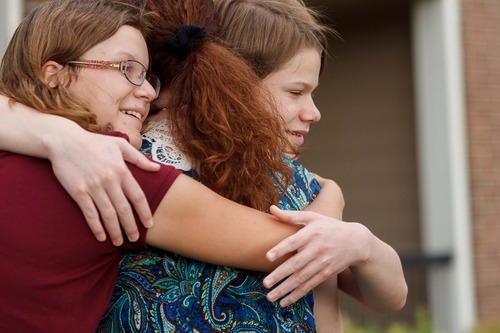This is an archived article that was published on sltrib.com in 2012, and information in the article may be outdated. It is provided only for personal research purposes and may not be reprinted.
In the weeks before Garrett Lines was hospitalized, he insisted on symmetry and separation. If he said "goodbye" and someone responded "see you later" instead of echoing him, he screamed. If he stepped on someone's shadow, he ran backward to escape. By the time he arrived at the state's hospital for the mentally ill, Garrett had tried to choke himself with his shirt, stuff his hand down his throat and jam a plastic knife in a light socket, hoping to electrocute himself.
Garrett was 12 years old. Diagnosed with autism at the end of kindergarten, he had access to only short-term crisis care and limited counseling due to the restrictions of his mother's private health insurance. Thirty-two states now require insurance companies to cover autism treatment. But Utah is not one of them.
For years, his mother said, his family endured what she considers acts of "terrorism" from Garrett.
As his violence increased at school, Nikki Lines hoped the juvenile justice system would help Garrett receive the services he needed. A judge eventually ordered him into the child welfare system, a move she encouraged, but with mixed feelings.
It was August 2008. Though officials had yet to begin tracking such cases, Garrett's surrender is not unique.
In 2010, Utah parents turned nine autistic children over to the child welfare system because their families couldn't afford mental health treatment. All were boys. In 2011, seven children, also all male, entered the system for the same reason.
The number stands at five so far this year, a blend of boys and girls.
Lines remembers feeling a combination of guilt and relief when Garrett began his stay at the hospital. She had been worried he would set fire to the family home or stab her in a rage.
"It just kept building and building and building, we were so, so scared about how bad it would get," she said. "There was no relief in sight."
—
Growing violence • In the beginning, Garrett's differences were easy for his mom to rationalize away. But she noticed he played in strange ways. Give him a battery-powered toy and he would find the most annoying sound on it.
Then he'd repeat that sound for an hour. In kindergarten, when other kids got too close or interrupted what he was doing, he ripped up their homework or stabbed them with a pencil. He was determined to always walk in a straight line.
His mom, who divorced Garrett's dad when the boy was a toddler, tried play therapy and various parenting approaches.
She reluctantly turned to antipsychotic medication by the time he was in fourth grade. But his aggressive behavior and depression only grew worse. From preschool on, Garrett was repeatedly in violent altercations with both teachers and students.
In March 2007, he was 10, weighed 65 pounds and started one school day by throwing a water bottle across his classroom. A few hours later, the fifth-grader pushed over desks and chairs, punched his female teacher twice in the right eye and tried to bite her, according to a police report.
In May 2008, Garrett slammed his elbow onto a student's head, grabbed another student's arm and tried to run out of the classroom. He flipped desks and ripped books.
When a staff member blocked his way, Garrett punched her in the right breast, according to police and court reports. He was taken to the Salt Lake Valley Detention Center to stay overnight.
The staff member he hit was worried that Garrett was "a safety risk in the community," a court report said. She did not think the school could "give him the help he needs to progress in his life at this time."
The 11-year-old had no friends and seemed to relate best to adults — not unusual for some autistic children.
In August, a counselor told a judge that the Utah Division of Child and Family Services (DCFS) had been working with the Lines family for several months on parenting approaches and had been looking for help for Garrett.
"I desperately wanted some magical thing I hadn't thought of before," said his mom. "[But] autism isn't caused by bad parenting. I'm sure good parenting can help the situation a bit, but it was way beyond that, through no fault of my own."
—
Insurance roadblock • His mother had called 911 several times that summer. Once, he jammed his knee into walls, making holes around their home and causing Lines to fear for both her and his safety. Another time, he opened a car door while his mother was driving. She pulled over. He ran from the car on the edge of the highway. The Utah Highway Patrol picked him up.
Lines remembers constantly crying and not being able to sleep. When she did rest, she struggled to wake up or would wake in a panic, bursting into tears. She was terrified of losing her job as a business analyst at Zions Bank. She couldn't calm her son down at the end of the day, as she had in the past.
There was little progress in Garrett's ability to learn "frustration tolerance and self-soothing skills," the DCFS report to the judge said, recommending Garrett be taken into state custody and enter residential treatment.
"Alternatives were explored through Nikki's insurance plan to avoid the need for Garrett to be placed into state custody," the court report said. "Based upon his primary Autism Spectrum Disorder diagnosis, Garrett's insurance provider will not authorize a higher level of care beyond crisis care stabilization and outpatient therapy."
State custody, the report pointed out, would make Garrett eligible for Medicaid, which covers more extensive therapy than private insurance typically allows.
"In this valley, Medicaid is the window for accessing many of the services that are in place for kids and adults who have developmental disabilities, autism included," said Deborah Bilder, an assistant professor at the University of Utah's department of psychiatry, who specializes in autism.
"If an individual does not meet criteria for Medicaid, typically because of their parents' income," she said, "it really restricts the services they can access unless their family is wealthy enough to afford expensive [behavior] therapy."
The state first sent Garrett to the Adolescent Residential Treatment and Education Center in Midvale, but officials quickly decided he "was not safe in their facilities," a court report said.
His mother recalls that he smashed a hole in a wall about the size of a pumpkin, hoarded rotting food and scabs he had picked off his skin, and he wouldn't shower or change his clothes.
He was sent temporarily to the University Neuropsychiatric Institute, where he had previously received crisis care. Days later, he was transferred to the Utah State Hospital, the state's facility for the most severely mentally ill.
Garrett would call it home for almost two years.
—
Growing up • Peter Bell, an executive vice president at the national group Autism Speaks, said he isn't surprised that parents of autistic children in Utah can become desperate enough to turn their son or daughter over to the child welfare system. That's why the advocacy organization continues to fight for insurance mandates, he said.
"The way you prevent it from happening is you help families get access to the treatment their children need and deserve," he said, adding that many children who receive help early may be able to become taxpayers later.
"There's both a fiscal and a moral imperative there," he said. "Unfortunately, people only focus on the short term."
In Utah and across the nation, critics say insurance mandates for autism are costly, could lead to higher insurance costs for everyone and say treatment is unproven.
Lines wishes Garrett had received earlier treatment so some of his behaviors wouldn't have become so entrenched. The challenges posed by Garrett and his younger sister, who also has mental health disorders and is on the autism spectrum, always illuminated the differences between their family and others.
"We were plagued by our most notable news being nobody was in the hospital or had been to court that year," Lines recalled. "It's almost like the child I thought I was going to have when I was young and naive — I've had to grieve the death of that person."
When Garrett's grandmother looks back to his earlier violent episodes, she attributes much of his behavior to boredom, particularly at school.
"That phenomenal mind of his needs stimulation," said Merlene Crapo, Lines' mother.
Ask Garrett now about why stepping on shadows bothered him, and he'll tell you it wasn't rational. The repetition in saying goodbye was an obsession. Asked whether he learned a lot in the state mental hospital, he answers, "Yeah," stroking his mother's arm, but he adds it was mainly academics.
Today he's a 16-year-old with two periodic tables on his bedroom wall who dreams of programming video games.
He lives with two autistic young adult apartment mates in a 24-hour supervised group home in Midvale, paid for by his parents and the state. He returned to his mom's custody at the end of 2010 and lived at home for about a year and a half.
After his violent episodes began to increase again, he moved into a group home last spring.
Garrett describes himself as having a high severity of autism but also a high IQ. At times, he stares vacantly or puts his head in his hands. Then he comes to life.
"I'm a nerd and a geek," he says, smiling widely and clapping several times quickly.
The teen says he acts out less often these days because he understands the consequences. He'd prefer to live with his mom but says he knows he doesn't because he was doing the "opposite of helping with her PTSD."
"It actually has more to do with you being unsafe," she said gently. "You were a danger to yourself and others."
As his mother stood to leave his apartment complex on a recent rainy night, Garrett stood close to her.
"So I can't be with you?" he asked.
She told him they'd see each other soon.
Autism in Utah
A study of a small area along the Wasatch Front found that 1 in 47 children in Utah may have autism — the highest rate in the nation — compared to 1 in 88 children across the country. In Utah, the rate is 1 in 32 boys versus 1 in 85 girls.
The state is launching a new autism treatment pilot program that will allow about 300 children to receive behavioral treatment. Most of those children will be covered by Medicaid. —
What is autism?
Autism includes a range of disorders that affect brain development. The resulting challenges may include difficulty speaking, repetitive behavior, problems with social interaction and others. To learn more, go to http://www.autismspeaks.org/what-autism —
Autism resources in Utah
A variety of Utah organizations serve the families of children with autism. They include:
Autism Council of Utah • autismcouncilofutah.org
Utah Parent Center • http://www.utahparentcenter.org
Utah Registry of Autism • http://www.utahautismregistry.com
Utah Autism Coalition • http://www.utahautismcoalition.org
Big MAKS • utahmaks.blogspot.com
Utah Easy to Love • utaheasytolove.blogspot.com













